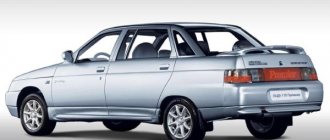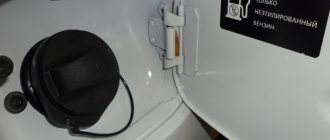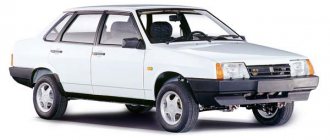Despite the fact that the domestic automobile sales market contains products from many foreign automakers, cars from the Volzhsky Automobile Plant (AvtoVAZ) continue to hold the palm in terms of the number of units on Russian roads. More than one generation of drivers have grown up on these cars and know the fuel consumption per 100 km of a particular model first-hand. And we provide standard fuel consumption indicators in the tables under the characteristics of each of the most popular VAZ modifications.
VAZ 2101
Under this name, the first Zhiguli model appeared at the Volzhsky Automobile Plant. The VAZ 2101 became a pioneer in the family of the most popular domestic cars, enjoying success both among Soviet drivers and abroad. This car rolled off the factory assembly line in 1970, and production of the “penny” continued until 1988, after which it was replaced by new modifications on the same platform. VAZ 2101 was recognized as “The best domestic car of the 20th century.” Over the entire production period, only one of two engine options was installed on this model: either a 1.2-liter engine with a capacity of 64 hp, or a 1.3-liter power unit with 69 “horses”. Both engines were accompanied by a four-speed manual transmission.
| Engine | Consumption (city) | Consumption (highway) | Flow (mixed) | Type of fuel |
| 1.2 MT 64 hp | 9.4 | 6.8 | 8.0 | Petrol |
| 1.3 MT 69 hp | 9.4 | 6.8 | 8.0 |
VAZ 21011
“Zero Eleven” or “Zhiguli-1300” is a modified model of the base VAZ 2101. The changes affected only the appearance (the radiator grille received more vertical bars, “fangs” disappeared from the bumpers and rubber pads appeared, brake lights received reflectors). The VAZ 21011 was equipped exclusively with a 1.3-liter engine with a power rating of 69 hp.
| Engine | Consumption (city) | Consumption (highway) | Flow (mixed) | Type of fuel |
| 1.3 MT 69 hp | 9.4 | 6.8 | 8.0 | Petrol |
VAZ 2103
Another of the pioneer models, which first rolled off the factory lines of the Volzhsky Automobile Plant in 1972. The VAZ 2103 sold well in the countries of the socialist camp, where it was delivered under the name Lada 1500. Production of the model was discontinued in 1984, replacing it with the more advanced “seven”. The Troika was equipped with one of three engines (1.2, 1.3 and 1.5 liters in volume and power of 64, 69 and 75 hp, respectively). All power units were accompanied by a four-speed “mechanics”, and fuel was supplied using a carburetor.
| Engine | Consumption (city) | Consumption (highway) | Flow (mixed) | Type of fuel |
| 1.2 MT 64 hp | 8.8 | 8.2 | 8.6 | Petrol |
| 1.3 MT 69 hp | 11.4 | 8.2 | 10.0 | |
| 1.5 MT 75 hp | 11.5 | 8.3 | 9.4 |
VAZ 2104
The model, created as a station wagon based on the VAZ 2102, has long been considered the cheapest station wagon among all cars sold on domestic car markets. The popularity of the 2104 lay in the fact that it was assembled from simple parts, and that spare parts for it were always easy to find. The model was produced at the factory from 1984 to 2012. During its production, the VAZ 2104 was equipped with one of four options for gasoline engines or a diesel power unit.
| Engine | Consumption (city) | Consumption (highway) | Flow (mixed) | Type of fuel |
| 1.3 MT 64 hp | 10.0 | 5.8 | 7.4 | Petrol |
| 1.5 MT 75 hp | 10.2 | 7.4 | 9.0 | |
| 1.6 MT 74 hp | 9.5 | 6.8 | 9.2 | |
| 1.7 MT 79 hp | 9.5 | 7.2 | 8.2 | |
| 1.5 MT 50 hp | 5.7 | 5.8 | 5.8 | Diesel |
Injector Car interior
But in the modern flow of traffic it’s impossible to drive calmly, they honk from behind, and in today’s hectic life you often have to rush, so driving smoothly, without acceleration, is not always possible. Checking the ignition timing and all marks on the pulleys and bosses of the engine will guarantee that the timing and injection timing are set correctly.
| Basic NRT | This is the standard cost of fuel and lubricants. Installed separately for each brand of vehicle. Takes into account individual designs, curb weight, type of fuel consumed and other characteristics. The type of flow is applicable for standard, typified situations. |
| Transport NZT | This type of regulatory use is applied taking into account the characteristics of the transport operation of the unit. In essence, this is a basic standard, recalculated taking into account the carrying capacity, towing force, and the rated load of cargo or passengers. That is, a standard taking into account the performance characteristics of the car. |
| Operational NRT | This is a real cost standard, which is recalculated taking into account correction factors. These are basic and transport NRT, which take into account the operating conditions of the vehicle (terrain, climate, temperature conditions and other operating features). |
VAZ 2105
“Five” is considered a legend of the domestic automobile industry, since its production continued for more than three decades. The first VAZ 2105 rolled off the assembly line in 1979, and the last representative left the factory gates in 2010. In the Soviet era, the “five” was considered a luxury item, and at the beginning of the new century it was the most affordable car, since its cost did not go beyond 180 thousand rubles.
The 2105 was equipped with one of four options for gasoline engines or a diesel engine. In power units with a volume of 1.2 and 1.3 liters, the fuel supply was provided by a carburetor, and injectors were installed on the 1.5-liter versions. Models with 1.6-liter engines could have both carburetors and injectors. All engines were paired with a five-speed manual transmission.
| Engine | Consumption (city) | Consumption (highway) | Flow (mixed) | Type of fuel |
| 1.2 MT 64 hp | 10.0 | 6.3 | 7.4 | Petrol |
| 1.3 MT 63 hp | 9.4 | 6.8 | 7.2 | |
| 1.3 MT 64 hp | 9.4 | 6.8 | 7.2 | |
| 1.3 MT 140 hp | 10.2 | 6.2 | 7.8 | |
| 1.5 MT 71 hp | 9.6 | 7.3 | 8.8 | |
| 1.5 MT 75 hp | 10.2 | 7.4 | 10.0 | |
| 1.6 MT 73 hp | 10.0 | 6.8 | 8.5 | |
| 1.6 MT 74 hp | 9.6 | 7.0 | 8.5 | |
| 1.5 MT 50 hp | 6.7 | 5.8 | 6.0 | Diesel |
Main characteristics of the model
In the large model range of Zhiguli cars, the VAZ-21074 stands apart. A powerful engine with a displacement of 1569 cm 3 gave it the right at that time to be considered the fastest rear-wheel drive sedan that rolled off the assembly line of the Volzhsky Automobile Plant.
On the first models of the 7th series, the engine was similar to the 5th model. Only a little later they began to install a more powerful engine from the no less popular VAZ-2106 car.
The vehicle's ground clearance is 17.5 cm. The installed tires have an outer radius of 165 mm. The volume of the luggage compartment is 355 liters. The total curb weight of the vehicle is 1430 kg. Maximum speed is 150 km/h. In 16 seconds the car accelerates to hundreds. A fuel tank of 39 liters allows you to store a fuel reserve of 400 km in urban mode.
The brake system did not change and was inherited from the prototype model - VAZ 2105. Initially, these cars were almost identical, but, nevertheless, they had certain distinctive features, namely:
- shape of the hood and trunk;
- radiator screen;
- rear lights;
- chrome bumper trims.
The car has proven itself to be unpretentious in operation, and the cost of spare parts is in an affordable price segment. This aspect is one of the main factors that positively influences the buyer’s choice (in favor of the VAZ-21074). We will consider the technical characteristics of components and assemblies in more detail below.
Fuel consumption VAZ 2106
“Six” is another representative of the classics of the Soviet automobile industry. Production of the VAZ 2106 started in 1976, and the last car rolled off the factory assembly line in 2006. During the entire production period, cars were produced only in a sedan body, equipped exclusively with gasoline power units. Fuel injection on all engines was carried out using a carburetor, and the gearbox was a four-speed manual.
| Engine | Consumption (city) | Consumption (highway) | Flow (mixed) | Type of fuel |
| 1.3 MT 64 hp | 9.4 | 7.6 | 8.3 | Petrol |
| 1.5 MT 72 hp | 9.7 | 8.0 | 8.8 | |
| 1.6 MT 74 hp | 10.3 | 7.4 | 9.0 | |
| 1.6 MT 75 hp | 10.3 | 7.4 | 9.0 | |
| 1.6 MT 75 hp | 10.1 | 7.4 | 8.9 |
Fuel consumption VAZ 2107
Production of the “Seven” began in Tolyatti in 1982, and for three decades this model was produced unchanged. The VAZ 2107 was equipped with various power units. The fuel supply in cars with 1.3- and 1.6-liter engines was provided by a carburetor, and in versions with 1.5- and 1.7-liter engines, an injector handled this function. The 2107 was equipped with a five-speed transmission.
| Engine | Consumption (city) | Consumption (highway) | Flow (mixed) | Type of fuel |
| 1.3 MT 64 hp | 9.4 | 6.8 | 8.3 | Petrol |
| 1.3 MT 135 hp | 11.2 | 6.4 | 8.2 | |
| 1.5 MT 68 hp | 8.9 | 7.4 | 8.5 | |
| 1.5 MT 72 hp | 8.9 | 7.4 | 8.5 | |
| 1.6 MT 74 hp | 9.7 | 7.2 | 8.4 | |
| 1.6 MT 75 hp | 9.6 | 7.0 | 8.4 | |
| 1.7 MT 80 hp | 8.8 | 7.4 | 8.4 |
Electronic control unit
Indeed, this is the heart of any injection machine. To understand its operation, it is necessary to consider the block diagram, which includes:
- Reading devices (sensors).
- Actuators (IAC, fuel pump, catalytic collector heater).
- Microcontroller with the required number of I/O ports.
But the whole problem is that the sensors produce different signals. Some have 12 volts output, while others have less than one. And the problem is that on a VAZ 2107 injector, fuel consumption will depend on the parameters coming from the sensors, and the microcontroller can only perceive a signal in the range of 3.5-5 Volts.
VAZ 2108
Production of a small-sized V8 with three doors began in Togliatti in 1984. Until 2005, when the model was discontinued, it did not see a single generation change, but was extremely popular throughout the Soviet and post-Soviet space. The 2108 was equipped with one of three types of gasoline engines. In a car with a 1.1-liter engine with 54 hp. The fuel supply was provided by a carburetor. On cars with an engine capacity of 1.3 liters and a carburetor, the power was 64 “horses”, and with an injector the power increased to 140 hp. 1.5-liter engines could produce either 70 or 78 “horses”.
| Engine | Consumption (city) | Consumption (highway) | Flow (mixed) | Type of fuel |
| 1.1 MT 54 hp | 8.2 | 5.2 | 6.8 | Petrol |
| 1.3 MT 64 hp | 8.6 | 5.4 | 7.0 | |
| 1.3 MT 140 hp | 9.5 | 7.8 | 8.2 | |
| 1.5 MT 70 hp | 8.6 | 5.7 | 7.8 | |
| 1.5 MT 78 hp | 8.0 | 5.4 | 6.7 |
Fuel consumption VAZ 2109
“Nine” is a five-door modification of the “eight”. Its production began in 1987 and was discontinued in 2004. Thanks to its interesting design, modern, at that time, interior design and front-wheel drive, the model was more popular than the 2108. The VAZ 2109 with engines of 1.1 and 1.3 liters had a fuel supply provided by the carburetor. On “nines” with 1.5-liter power units, the carburetor version developed 72 hp, and the injection version – 78 hp.
| Engine | Consumption (city) | Consumption (highway) | Flow (mixed) | Type of fuel |
| 1.1 MT 54 hp | 8.0 | 5.3 | 7.0 | Petrol |
| 1.3 MT 64 hp | 8.6 | 5.4 | 6.2 | |
| 1.5 MT 72 hp | 8.0 | 5.5 | 7.7 | |
| 1.5 MT 78 hp | 8.0 | 5.4 | 6.2 |
Fuel consumption VAZ 2110
The production of the “ten” in Tolyatti began in 1996. Some observers of new automobile industry products believed that the car did not meet the demands of the time in terms of comfort and technical equipment, but in comparison with previous models, it was a real breakthrough in the domestic automotive industry. The VAZ 2110 was produced in a sedan body, and hatchbacks and station wagons created on its platform made up other models. The “ten” was discontinued in 2007. The car was equipped with various versions of power units that were paired with a five-speed manual transmission.
| Engine | Consumption (city) | Consumption (highway) | Flow (mixed) | Type of fuel |
| 1.5 MT 73 hp | 8.8 | 6.0 | 7.5 | Petrol |
| 1.5 MT 79 hp | 10 | 5.6 | 8.0 | |
| 1.5 MT 92 hp | 9.8 | 6.0 | 7.4 | |
| 1.5 MT 94 hp | 8.8 | 5.5 | 7.2 | |
| 1.5 MT 50 hp | 5.7 | 5.8 | 5.8 | |
| 1.6 MT 81 hp | 8.0 | 7.0 | 7.5 | |
| 1.6 MT 89 hp | 10.0 | 5.8 | 7.7 | |
| 1.6 MT 90 hp | 7.8 | 5.5 | 7.2 | |
| 1.8 MT 98 hp | 9.8 | 6.0 | 7.7 | |
| 2.0 MT 150 hp | 10.5 | 6.5 | 8.2 |
INCREASED CONSUMPTION, WHAT TO DO
Let's look at the main points that car owners face.
SIGNS
Consumption of fuel above the norm is a phenomenon that occurs quite often. Therefore, many car owners are often interested in how to reduce fuel consumption on a VAZ 2114. If the driving style does not raise any doubts in terms of accuracy, and it’s summer and the roads are smooth, then you need to pay attention to the technical condition of the car to see if this is the reason. High fuel consumption may be accompanied by the following symptoms:
- There is black exhaust coming from the muffler pipe. It is most noticeable when you sharply press the gas pedal;
- The engine runs unsteadily (troits), does not develop speed, the car drives jerkily;
- The motor runs smoothly, but is “dull” and lacks power;
- Popping sounds in the muffler or intake manifold;
- The Check Engine diagnostic light is on inside the car.
Check Engine light on
CAUSES
The reasons for high fuel consumption can be so different that a simple car enthusiast will most likely be able to understand only the most standard and simple cases. Often many signs are interrelated. For example, black smoke from the exhaust pipe may be accompanied by popping noises.
Black smoke indicates the fuel mixture is too rich. Causes:
- The settings of the engine control unit are lost;
- Nozzles are clogged;
- Spark plugs are faulty;
- The MAF (air flow sensor) is acting up;
- The fuel pressure regulator creates excess pressure in the fuel system;
- The camshaft position sensor does not work.
High fuel consumption of the VAZ 2114, accompanied by unstable engine operation:
- The idle speed controller has failed;
- The exhaust valve in one of the cylinders burned out;
- High-voltage wires are faulty;
- Weak compression in the cylinders, the piston group requires repair (replacement of piston rings, boring of cylinders);
- There are defects in the ignition coil;
- There is air leakage through the intake manifold.
It would seem, how can there be increased fuel consumption when the fuel mixture is obviously lean during suction? The thing is that the proportion of air and fuel must still be observed. And more air requires more gasoline.
The engine runs smoothly, but the car drives poorly, and the fuel quickly disappears from the tank:
- Malfunctions in the brake system (the working brake cylinder is jammed, the handbrake is not adjusted).
- The air filter element is clogged.
- Retarded ignition is set on the engine control unit.
- The oxygen sensor is faulty, the catalyst is clogged.
- The tank is filled with gasoline with a low octane number, or the fuel contains unwanted impurities (for example, water).
Protect your car from low-quality fuel - refuel only at proven gas stations.
Sometimes there are such cases that it takes a long time to guess why fuel consumption has increased and the car does not drive. Let’s say, this is an interesting point: experts found the solution only two weeks after the defect appeared. The car was "eating" gasoline and stubbornly did not want to go above a speed of 90 km/h. It was the muffler. The partition inside the can fell off and half blocked the path to the exhaust gases. There seems to be exhaust from the pipe, but the car does not drive. After replacing the muffler everything fell into place.
INFLUENCE OF SENSORS ON FUEL CONSUMPTION
Many sensors affect fuel consumption in cars with an injector fuel system. But it’s probably not worth blindly asserting that fuel consumption will immediately increase due to a malfunction of any sensor. For example, a knock sensor only prevents detonation knock when refueling a car with low-quality gasoline and commands the control unit to set a later ignition. With high-quality fuel, consumption will be normal.
Increased gasoline consumption will not be too noticeable even if the throttle sensor is faulty; it depends more on driving style. When you smoothly press the gas pedal, the fuel does not “fly out” into the pipe. Another thing is that if the car is constantly jerking, it is almost impossible to drive.
Malfunctions of the air flow sensor (or absolute pressure sensor), lambda probe, and phase sensor (camshaft position) have a noticeable effect on gasoline consumption. But the “dying” of the crankshaft sensor more often leads to the fact that the engine completely stops starting.
WHAT TO DO
What can an ordinary car enthusiast do with his own hands to somehow reduce the “gluttony” of his car?
We should not forget that timely prevention is simply necessary for normal fuel consumption.
To do this you need:
- Change the air filter element periodically. In this case, factory elements should be installed (a dense fabric filter may have greater air flow resistance);
- Carry out preventive maintenance of spark plugs and change them on time;
- Monitor the condition of the brake system and tire pressure;
- Keep the engine compartment clean. Salting of high-voltage wires leads to the fact that the motor begins to trip;
- Refuel at reputable gas stations.
And in case of malfunctions in the engine or fuel system, diagnostics should be carried out by contacting specialists!!! Article 4: Technical characteristics of the VAZ 2114 engine
VAZ 2111
This model is a modification of the “ten” with a station wagon body. At the Togliatti plant, such cars were assembled from 1998 to 2009, and at several subsidiaries, production of the VAZ 2111 continued until 2014. The main power unit on this car has always been a 1.5-liter engine with different power ratings, depending on the number of valves. Some buyers were more impressed by options with a 1.6-liter engine. On cars with an engine capacity of 1.7 and 1.8 liters, all-wheel drive was installed, while smaller displacement cars were equipped with only front-wheel drive.
| Engine | Consumption (city) | Consumption (highway) | Flow (mixed) | Type of fuel |
| 1.5 MT 72 hp | 9.0 | 7.5 | 8.2 | Petrol |
| 1.5 MT 79 hp | 10 | 5.7 | 7.2 | |
| 1.5 MT 92 hp | 8.8 | 5.6 | 7.6 | |
| 1.5 MT 94 hp | 9.0 | 7.5 | 8.2 | |
| 1.6 MT 81 hp | 9.0 | 5.6 | 7.5 | |
| 1.6 MT 89 hp | 9.0 | 7.5 | 8.2 | |
| 1.6 MT 90 hp | 10.0 | 5.8 | 7.3 | |
| 1.7 MT 90 hp 4x4 | 11.8 | 9.5 | 10.2 | |
| 1.8 MT 98 hp 4x4 | 11.8 | 9.5 | 10.2 |
Engine tuning
When seriously considering the issue of tuning for a car such as VAZ (Lada) 211440, it is worth noting the fact that the car is perfect for such a bold undertaking. Professional modernization will allow it to reach incredible speeds, up to 200 km/h, and will also give it excellent handling. This model is available with many tuning packages, created taking into account different needs and wishes. If you want to get the most out of your car, there are all possibilities for this. Spare parts can be purchased at car markets and specialized stores. Fortunately, there are quite a few of these operating.
One of the most popular modifications is engine improvement, which allows you to significantly increase the power of the base engine or completely replace it with a sports analogue. For small tuning, it is enough to reflash the control unit, as well as replace several factory parts. After simple steps, the performance of the power unit can increase by 10-15%. If you want to further improve the engine, you need to change the cylinder head, bore the valves and install a new mechanism that distributes gas.
For real extreme sports enthusiasts, there are radical methods to increase engine power. For example, you can install a turbine on the VAZ-11440 engine or replace the old crankshaft with a sports version with an increased piston stroke. The latter will provide more torque, increasing the performance of the power unit. This option is quite risky, so you need to approach the decision carefully. There are also factory modifications of the engine, an example of which is the VAZ-211440 engine. 11183 with increased torque.
When tuning a gearbox, you need to change the gear ratios. The main gear and row are selected depending on the specific types of engine, which will be explained to you in detail in workshops and stores. Self-locking differentials can significantly increase the transmission of torque to the car's wheels, allowing for a significant increase in low-end traction during intense acceleration.
Fuel consumption VAZ 2112
This car is a hatchback version of the Ten. It was produced at the Volzhsky Automobile Plant from 1999 to 2008 in three-door or five-door modifications. The main advantage of the VAZ 2112 was the trunk with a volume of 400 liters. For the entire production period, cars of this model were equipped only with gasoline engines of varying power, which were paired with a five-speed manual transmission.
| Engine | Consumption (city) | Consumption (highway) | Flow (mixed) | Type of fuel |
| 1.5 MT 72 hp | 9.0 | 5.6 | 7.3 | Petrol |
| 1.5 MT 78 hp | 10.0 | 5.7 | 7.3 | |
| 1.5 MT 92 hp | 9.8 | 6.1 | 7.3 | |
| 1.5 MT 94 hp | 9.4 | 6.0 | 7.2 | |
| 1.6 MT 81 hp | 10.0 | 6.0 | 8.5 | |
| 1.6 MT 90 hp | 9.4 | 5.8 | 7.0 | |
| 1.8 MT 98 hp | 10.0 | 6.0 | 8.5 |
Calculation for passenger cars. Vehicle interior
| Fuel consumption on a VAZ 2107: injector, carburetor The pursuit of saving fuel consumption can turn into a disaster, because low-octane gasoline will not only increase fuel production many times over, but will also actively accelerate engine wear. Increased fuel consumption is even affected by the condition of the braking system; if one of the working cylinders is faulty, the car will begin to slow down, and the driving resistance will increase in this case. |
- in suburban mode - 7.3 l;
- in the city - 9.7 l;
- in mixed mode - 8.5 l.
VAZ 2113
The production of this three-door hatchback, which contains basic elements of the VAZ 2108 and VAZ 2115, began in 2004 and was produced until 2014, being removed from the assembly line only after the appearance of more modern models. The cars of this series were equipped with gasoline engines with fuel injection, which worked in conjunction with a five-speed manual transmission.
| Engine | Consumption (city) | Consumption (highway) | Flow (mixed) | Type of fuel |
| 1.5 MT 79 hp | 9.2 | 7.6 | 8.4 | Petrol |
| 1.6 MT 81 hp | 10.0 | 5.7 | 7.6 | |
| 1.6 MT 98 hp | 9.8 | 5.2 | 7.4 |
VAZ 21099
This model is perhaps the most popular sedan in the CIS countries. Its production began in 1990 and successfully continued until 2004. The VAZ 21099 was assembled in Ukrainian factories until 2011. The car differed from its predecessors in the presence of a dashboard, additional body kits and interior trim. Depending on the year of manufacture, the car could have one of five types of engines. Modifications of 1.3-liter power units were accompanied by a carburetor fuel supply, and on 1.5-liter versions either a carburetor or an injector was installed. All models had a five-speed manual transmission.
| Engine | Consumption (city) | Consumption (highway) | Flow (mixed) | Type of fuel |
| 1.3 MT 64 hp | 9.1 | 5.8 | 7.7 | Petrol |
| 1.3 MT 135 hp | 12.5 | 7.0 | 10.0 | |
| 1.5 MT 70 hp | 9.1 | 5.7 | 7.7 | |
| 1.5 MT 78 hp | 8.8 | 5.3 | 7.3 | |
| 1.6 MT 81 hp | 9.0 | 5.8 | 7.8 |
Fuel consumption VAZ 2115
The car, which replaced the popular VAZ 21099 model, was produced as a sedan from 1997 to 2012 and was discontinued after the development of the new Lada. The model was equipped with one of six types of engines, which were paired with a five-speed manual transmission.
| Engine | Consumption (city) | Consumption (highway) | Flow (mixed) | Type of fuel |
| 1.3 MT 135 hp | 12.5 | 7.5 | 10.0 | Petrol |
| 1.5 MT 68 hp | 8.8 | 5.7 | 7.8 | |
| 1.5MT 76 hp | 8.6 | 6.5 | 7.2 | |
| 1.5 MT 78 hp | 10.0 | 5.6 | 7.2 | |
| 1.6 MT 80 hp | 10.1 | 5.7 | 7.6 | |
| 1.6 MT 81 hp | 10.0 | 5.7 | 7.6 |
Technical features affecting fuel economy
From the functional and technical side, fuel consumption is affected by:
- condition of the cylinder-piston group - when worn, consumption increases by 20-25%,
- coolant temperature – when it decreases relative to the optimum, the overconsumption increases by 8-10%,
- high oil density, especially in winter, when friction in the engine and transmission increases losses,
- clutch slipping,
- a jammed brake caliper and an unadjusted brake system as a whole,
- underinflated tires (a more economical option - slightly overinflated by 0.2 atm.),
- over-tightened wheel hub bearings add another 10-15% to the consumed volume of fuel.
VAZ 2131
This car is better known as Niva 2131. Initially, such cars, built on the basis of the Niva 2121, but with a longer body, were intended for export. But due to their good cross-country ability and relatively low price, they have gained popularity in the domestic market. Production of the VAZ 2131 started in 1993 and continued until 2016, when it was replaced by a newer version, the Lada 4×4 Urban. The VAZ 2131 was equipped with one of five gasoline engines or a diesel power unit.
| Engine | Consumption (city) | Consumption (highway) | Flow (mixed) | Type of fuel |
| 1.7 MT 79 hp | 13.7 | 9.8 | 12.0 | Petrol |
| 1.7 MT 80 hp | 13.7 | 9.8 | 12.0 | |
| 1.7 MT 83 hp | 13.7 | 9.8 | 12.0 | |
| 1.8 MT 82 hp | 13.8 | 12.0 | 13.2 | |
| 1.8 MT 84 hp | 13.8 | 12.0 | 13.2 | |
| 1.9 MT 50 hp | 9.7 | 6.8 | 7.6 | Diesel |
The actual fuel consumption of VAZ models per 100 km may differ from the standard data specified in the tables, and it can only be determined experimentally. It is important to remember that average fuel consumption can differ significantly in winter and summer. If fuel consumption is much higher than the average values given in the tables, the car must be taken to a mechanic service station and, after determining all the factors of increased consumption, it may be worth switching it to gas.
Is it possible to reduce injector consumption? Engine characteristics
| Description, design and technical characteristics of the VAZ 21074 injector: filling capacities, fuel consumption and other data - MasterAuto During this time, a Volkswagen Golf of the same year of production could accelerate to 200 km h, and a mid-range sports car could enter Earth orbit, but this was not appreciated seven. The car was produced in 2010, there is nothing new to tell about it, but it copes with its tasks and surprisingly rarely fails on the road. |
| Fuel consumption per 100 km VAZ-2104 (injector, carburetor): characteristics - Website about the domestic automobile industry Having checked the injector, it is necessary to eliminate the identified problems; often repairs do not require significant costs; it is enough to replace the air filter or flow sensor. According to the requests of the factory developers, which corresponded to the reviews of the owners, the car with an 81-horsepower engine had the same fuel consumption per hundred kilometers. |
- 90 km/h;
- 120 km/h;
- driving in an urban environment.
Model VAZ 2103 • Technical characteristics of VAZ 21074.











